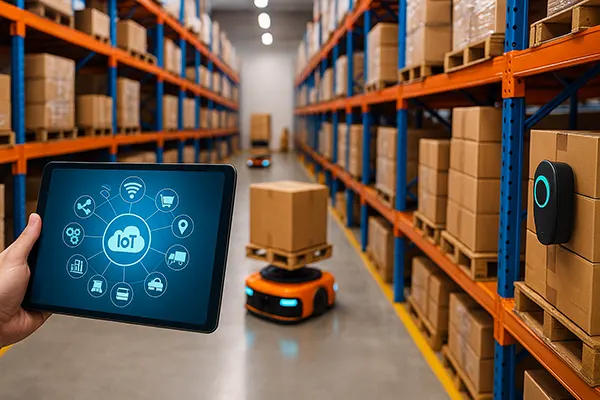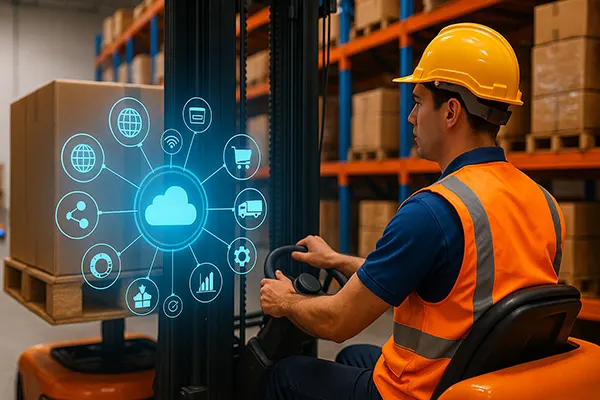
Industry 4.0 in Retail: How IoT Devices Optimise Inventory and Logistics
Retail is undergoing a profound transformation, driven by Industry 4.0 technologies that bring automation, real-time data, and smart systems into everyday operations. One of the most significant drivers of this shift is the integration of Internet of Things (IoT) devices. By enabling continuous monitoring and intelligent decision-making, IoT tools help businesses streamline inventory management and logistics, making supply chains more resilient and customer service more efficient. As we move deeper into 2025, IoT adoption in retail continues to rise, with companies investing heavily in these solutions to stay competitive in a rapidly evolving market.
Smart Inventory Management Through IoT
One of the primary challenges retailers face is maintaining the right level of stock without overburdening storage facilities or risking shortages. IoT-enabled sensors and RFID tags provide real-time visibility of inventory across warehouses and stores. This makes it possible to track the movement of goods at every stage, reducing the risk of human error and minimising losses caused by misplaced products.
Retailers now use predictive analytics powered by IoT data to forecast demand with greater accuracy. By analysing purchasing trends, seasonal behaviour, and even local events, systems can recommend optimal stock levels automatically. This approach allows businesses to respond quickly to changes in demand, avoiding costly overstocking or understocking scenarios.
Another benefit of IoT in inventory management is the automation of restocking processes. For example, smart shelves equipped with weight sensors can detect when stock levels are low and trigger automatic orders from suppliers. This ensures continuous availability of popular products while reducing manual workload for employees.
Enhancing Transparency Across the Supply Chain
Transparency is a critical component of modern retail operations. IoT devices provide end-to-end visibility by monitoring the movement of goods from manufacturers to distribution centres and finally to stores. GPS trackers and IoT sensors allow businesses to follow shipments in real time, providing accurate arrival estimates and improving coordination with logistics partners.
This visibility not only enhances trust between stakeholders but also enables faster responses to disruptions such as delays, shortages, or damaged goods. By having access to real-time data, companies can make more informed decisions, reroute shipments when necessary, and avoid potential bottlenecks in the supply chain.
Furthermore, customers benefit from greater transparency through features like order tracking and delivery updates. These improvements in communication strengthen consumer trust and contribute to better overall shopping experiences.
IoT and Logistics Efficiency
Logistics represents another area where IoT technology plays a vital role. Smart fleets equipped with telematics systems monitor vehicle performance, fuel consumption, and driver behaviour, helping companies reduce costs while maintaining timely deliveries. These systems can suggest optimal delivery routes by considering traffic conditions, weather, and fuel efficiency.
IoT-powered warehouses are also becoming more common, with automated guided vehicles (AGVs) and robotic arms handling repetitive tasks. By integrating sensors into these systems, retailers can improve accuracy in order picking and packing, ultimately reducing shipping errors and returns.
Cold chain logistics in sectors like food and pharmaceuticals is also benefiting from IoT. Sensors monitor temperature and humidity during transportation, ensuring that perishable products arrive in perfect condition. If conditions deviate from safe parameters, alerts are triggered instantly, allowing corrective measures to be taken before the goods are compromised.
Reducing Costs and Environmental Impact
Efficiency in logistics goes hand in hand with sustainability. By using IoT-based route optimisation and predictive maintenance, companies cut fuel consumption and reduce emissions, aligning their operations with growing environmental standards. This not only benefits the planet but also helps retailers meet consumer expectations for eco-friendly practices.
IoT devices also support circular logistics by tracking packaging materials and enabling their reuse. This reduces waste and contributes to a more sustainable supply chain model, which is increasingly important in 2025 as regulations and customer preferences shift towards greener solutions.
From cost savings to compliance with sustainability goals, the environmental advantages of IoT in logistics strengthen the business case for wider adoption. Companies that embrace these technologies gain both economic and reputational benefits, positioning themselves as responsible and forward-thinking organisations.

The Future of IoT in Retail
The role of IoT in retail is expected to expand even further over the next few years. As artificial intelligence and machine learning become more integrated with IoT systems, the potential for automation and predictive capabilities will grow. This will allow businesses to anticipate issues before they occur and optimise their operations in real time.
Retailers are also investing in digital twins—virtual models of supply chains that simulate operations using IoT data. These models help companies test scenarios, identify vulnerabilities, and plan strategic improvements without disrupting ongoing operations.
Security and data privacy remain key concerns, especially as the volume of connected devices grows. To address these challenges, retailers are implementing stronger cybersecurity measures and working with trusted technology providers to ensure compliance with international standards.
Building Competitive Advantage with IoT
In 2025, the competitive landscape in retail increasingly depends on the ability to use IoT effectively. Companies that adopt these technologies not only improve operational efficiency but also enhance customer satisfaction by offering reliable product availability and timely deliveries. This combination builds long-term loyalty in a market where consumer expectations are constantly rising.
Smaller retailers are also beginning to benefit from more affordable IoT solutions, closing the gap with larger competitors. Cloud-based IoT platforms make it easier for businesses of all sizes to implement these systems without major upfront investments, democratising access to advanced technologies.
Ultimately, IoT devices are no longer optional add-ons but integral tools for future growth. Retailers that embrace this shift position themselves as leaders in an industry shaped by innovation, efficiency, and customer-centric strategies.
